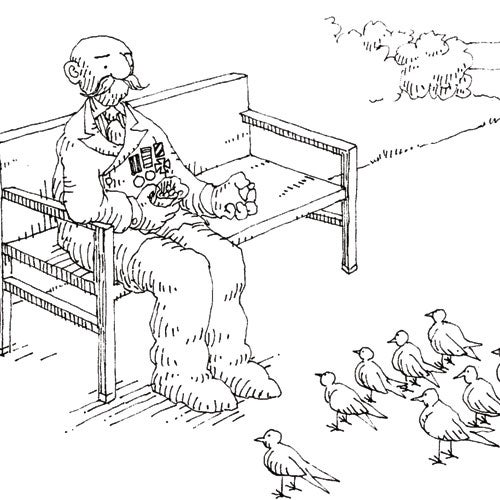Simon Bond: Cartoonist and illustrator best known for his book ‘101 Uses of a Dead Cat’

Though he had worked as a stand-up comedian, as a dealer in antiquarian prints and paintings, and as a writer and publisher, Simon Bond was best known as a cartoonist and illustrator, notably creating the international bestseller, 101 Uses of a Dead Cat.
Simon Patrick Everett Bond was born of British parents on 19 August 1947 in New York City. He was the second son of Terence Bond, a political secretary at the United Nations, and Hilda Everett. He had an older brother, Timothy, and a younger twin brother, Nicholas. The family returned to England when he was four and settled at first in Nottingham, where he attended Forest Fields School.
They then moved to London, where he attended Preston Manor County Grammar School, Wembley, before studying graphics at West Sussex College of Art and Design in Worthing (1965–68). His first job was as a paste-up artist on Tatler magazine (1969–70) and he was then briefly manager of a jewellery shop in Luton, Bedfordshire, before returning to the US on health grounds in 1970.
For more than a decade he livedin Phoenix, Arizona, where the climate was better suited to his chronicasthma. He then worked in a variety of jobs, including dealing in antiquarian prints and pictures and performing stand-up comedy in clubswhile also contributing cartoons to the Saturday Evening Post, Esquire, National Lampoon, New Yorker, Men Only and Vole.
In 1976 he published his first book, Real Funny (1976), and soon afterwards mentioned the idea for a macabre cartoon book about dead cats to his friend, Terry Jones of Monty Python, who he had met in London. Jones liked the idea and recommended it to the British publisher Methuen, who published it as 101 Uses of a Dead Cat (1981) (in the US the title was changed to 101 Uses for a Dead Cat). The book was an instant and enduring success, eventually selling more than two million copies and being published in 20 countries. Despite frequent attacks by cat lovers (Time magazine called him "the Charles Addams of ailurophobia"), Bond always maintained that he meant no harm by the book and was not only fond of cats but had even owned four himself at various times (as well as a dog); the only problem was that he was allergic to them.
At first he had no plans for a follow-up cat book and concentrated on a screenplay, Shorts, satirising the media, and another cartoon collection for Methuen, Unspeakable Acts (1982). However, in 1982 he returned to London, began contributing to Punch and Private Eye, and produced a new cat collection, 101 More Uses of a Dead Cat (1982) with tie-in calendars appearing in 1983 and 1984.
In 1985 he married Linda Marshall, who he had met in 1982 when she was studying engineering at university in Phoenix (her home town), and moved to the Jacobean Great Addington Manor near Kettering in Northamptonshire. Here he continued to produce at least one cartoon book a year, including Uses of a Dead Cat in History (1992). In 2001, to mark the 20th anniversary of the first book, Methuen published Complete Uses of a Dead Cat (2001), incorporating all three volumes. More recently, a 25th anniversary edition of the original book was published (in 2006) with a new foreword. In 1993 Bond and his wife moved to Langer, Nottingham, then returned to London in 1995 before finally settling in Northamptonshire in 1999.
In all he published more than 20 collections of drawings, including Odd Visions and Bizarre Sights (1983), Uniformity (1986), A Bruise of Bouncers (1987), Battered Lawyers and Other Good Ideas (1989), Odd Dogs (1989), Holy Unacceptable (1990), Commuted to Life (1992), Everybody's Doing It (1993) and three children's books featuring the teddy bear Tough Ted. He also illustrated two books by Alan Abel, Don't Get Mad, Get Even! A Manual for Retaliation (1983) and How to Thrive on Rejection: A Manual for Survival (1985), as well as Percy Richer's Richer's Legal Nuggets (1987) and Tom Isitt's Secrets of the Queen's Closet (1988). His last published book was 101 Uses of a Dead Roach (2002) with an "epitaph" by the celebrity drug-dealer Howard "Mr Nice" Marks.
A great admirer of the British caricaturist RS Sherriffs (1906-60), whose work he collected, he also published and edited a book, Sherriffs at the Cinema (1985), with an introduction by Nicholas Bromley, and organised a tie-in exhibition of the artist's drawings at the National Theatre in London.After the demise of Punch in 1992, Bond became the publisher and co-editor (with Will Adams) of a short-lived, 84-page, satirical monthly magazine, Squib: The Magazine of Comedy Allsorts (1992–93).
Bond, who once said that he loved thinking up ideas but truly hated drawing, usually sketched his cartoons with a 2H pencil on A4 cartridge paper, working up the finished drawing with a fine Edding needlepoint nylon-tip pen. However, for his bookwork he tended to draw actual size. He never used washes, tints or cross-hatching, preferring to draw up-and-down lines for shadows. For colour work he preferred coloured pencils.
Below average height (he was 5ft 3in tall), he spoke with a soft English accent, had brown hair, a brown beard and blue eyes, and usually wore spectacles. He was a keen collector of antiques and was also very interested in sport, especially cricket and football (he was an ardent supporter of Nottingham Forest FC).
Simon Patrick Everett Bond, cartoonist and illustrator: born New York 19 August 1947; married 1985 Linda Marshall; died Northamptonshire 22 June 2011.
Join our commenting forum
Join thought-provoking conversations, follow other Independent readers and see their replies
Comments